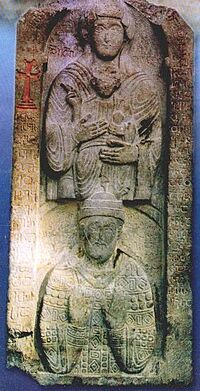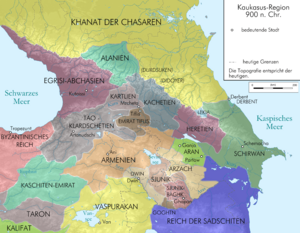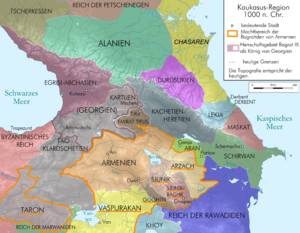Kingdom of the Iberians facts for kids
Quick facts for kids
Kingdom of the Iberians
ქართველთა სამეფო
kartvelta samepo |
|||||||||||
|---|---|---|---|---|---|---|---|---|---|---|---|
| 888–1008 | |||||||||||
|
Flag
|
|||||||||||

Boundaries of the Kingdom
|
|||||||||||
| Capital | Artanuji Bana |
||||||||||
| Common languages | Georgian | ||||||||||
| Religion | Eastern Orthodox (Georgian Orthodox Church) | ||||||||||
| Government |
|
||||||||||
| Prince | |||||||||||
|
• 813–826
|
Ashot I of Iberia | ||||||||||
|
• 826–876
|
Bagrat I | ||||||||||
|
• 876–881
|
David I | ||||||||||
| King | |||||||||||
|
• 888–923
|
Adarnase IV | ||||||||||
|
• 923–937
|
David II | ||||||||||
|
• 937–945
|
Bagrat I | ||||||||||
|
• 958-994
|
Bagrat II | ||||||||||
|
• 994–1008
|
Gurgen | ||||||||||
| Historical era | Early Middle Ages | ||||||||||
|
• Established
|
888 | ||||||||||
|
• Disestablished
|
1008 | ||||||||||
|
|||||||||||
| Today part of | Georgia Turkey |
||||||||||
The Kingdom of the Iberians was a medieval Georgian kingdom. It was ruled by the Bagrationi dynasty and began around 888 AD. This kingdom took over from the Principality of Iberia. It was located in the historical region of Tao-Klarjeti. This area is in what is now north-eastern Turkey and parts of south-western Georgia.
This region was very important for uniting all Georgian lands. It helped bring together different Georgian areas and kingdoms. This led to the creation of the larger Kingdom of Georgia in 1008. The land itself was mountainous, with important rivers like the Çoruh and the Kura.
Contents
History
How the Kingdom Started
In 813, Ashot I of Iberia, a prince from the Bagrationi dynasty, settled in his family's land, the Duchy of Klarjeti. He rebuilt the Artanuji castle, which was very old. The Byzantine Empire offered him protection. Ashot was recognized as a prince and leader of Iberia. He fought against the Arabs, slowly taking back lands they controlled.
Ashot I encouraged Georgians to move back to these areas. He also supported the growth of monasteries, especially those started by Gregory of Khandzta. This made Tao-Klarjeti a safe place for Georgian culture. It also became a very important religious center for the Georgian Orthodox Church. Because of this, the main political and religious center of Iberia moved to Tao-Klarjeti. This region was located between powerful empires. It was also on a branch of the Silk Road. This meant it was always influenced by different cultures.
Local Arab leaders in the Caucasus were becoming more independent. So, the Caliph recognized Ashot as prince of Iberia. This was to help Ashot fight against the rebellious Emirate of Tbilisi. Ashot joined forces with King Theodosius II of Abkhazia. They won a battle against the emir and pushed back other groups. However, when a new governor took control of eastern Georgia, Ashot had to retreat to Tao-Klarjeti.
Dividing the Land
When Ashot the Great died, he divided his lands among his three sons:
- The oldest son, Adarnase II of Tao-Klarjeti (826–869), was a grand duke. He ruled the capital, Artanuji, and the central areas of Shavsheti and western Klarjeti.
- The middle son, Bagrat I of Iberia (826–876), ruled the district of Kola and most of Tao. This area reached far into Anatolia and became very important.
- The youngest son, Guaram Mampali (826–882), ruled the northern parts: Samtskhe, Javakheti, and Trialeti. He had a special title, Mampali, which meant 'ruler'.

After Ashot's death, the Arabs took control of central Iberia (Kartli). They demanded taxes from the remaining Georgian lands. Bagrat I allied with the Caliph against the Emirate of Tbilisi. In 853, Bagrat briefly regained central Iberia. But then the Abkhazians pushed him out of the region.
Ashot's oldest son, Grand Duke Adarnase II of Tao-Klarjeti, died first. His lands were divided between his sons. Gurgen I of Tao received Tao, and Sumbat I Mampali received Klarjeti.
Ashot's youngest son, Guaram, tried to expand his territory. In 880, he captured the Arab emir of Tbilisi and sent him to Constantinople. This victory helped him gain Trialeti and Javakheti. Before 876, Guaram gave some of his lands to his brothers. He then retired to a monastery, where he died in 882.
Family Conflicts
A noble named Liparit took over Trialeti. He built a fortress called Klde-Karni. He then became loyal to Guaram's nephew, David I of Iberia, after 876. These changes left Guaram's son, Nasra of Tao-Klarjeti, with no land. This likely led him to murder his cousin David I in 881. After the murder, Nasra fled to the Byzantine Empire. His brother-in-law, Bagrat I of Abkhazia, helped him get Byzantine military aid. They then invaded the Bagratid lands for Nasra.
To balance the Byzantine influence, Ashot I of Armenia supported David I's son, Adarnase IV of Iberia. This family feud turned into a bigger regional conflict. Nasra captured some forts but was eventually defeated, captured, and killed at Aspindza.
Adarnase was still young. So, the Byzantine emperor appointed his cousin, Gurgen I of Tao, as the new leader. Adarnase then started to expand his territory from his base in Lower Tao. He was inspired by Armenia and took the title of king. Relations between Adarnase and Gurgen became tense and led to war. Gurgen was badly wounded and captured by Adarnase and his ally in 891. The Byzantine government then recognized Adarnase as the new leader after Gurgen's death.
Gurgen I of Tao had two sons, Adarnase III of Tao and Ashot the Immature. They started the "first house of Tao" branch of the Bagratid family. This line ended with Gurgen's grandson, Gurgen II of Tao (ruled 918–941).
The Kingdom is Restored
Adarnase was very loyal to Ashot I of Armenia for his help. This loyalty continued with Ashot's successor, Smbat I of Armenia. Adarnase helped Smbat become king in 890. They also fought together against a former governor of Armenia. In return, Smbat recognized Adarnase as a king and crowned him in 899.
The two kings worked together to defeat Constantine III of Abkhazia in 904. Constantine was a relative who competed with Adarnase for power in central Iberia. Adarnase captured Constantine and gave him to Smbat. However, Smbat freed Constantine. This made Adarnase angry and turned him against Smbat. This conflict weakened both kings. Adarnase lost his lands to Constantine III in 904. Smbat was defeated and killed by a ruler from Azerbaijan in 914. Because of these events, Adarnase was left with only his family lands in Tao. This marked the beginning of almost sixty years where Abkhazia dominated Iberia.
When Adarnase died, his lands were divided among his sons:
- The oldest son, David II of Iberia (ruled 923–937), only controlled Javakheti and Artaani. The main lands of central Iberia were under Abkhazian control.
- The second son, Ashot II of Tao (ruled 937–954), originally held Lower Tao. He also received Phasiane from the Byzantine emperor around 952.
- The third son, Bagrat I of Tao (ruled 937–945), gained Upper Tao after his relative Gurgen II of Tao died.
- The youngest son, Sumbat I of Iberia (ruled 954–958), received lands and titles after his brother Ashot II died.
Even though David II was a king, he did not have the important Byzantine title of curopalates. This title was given to his younger brother, Ashot II. David only had the title of magistros. As a result, his younger brother's influence was greater. Both Gurgen II of Tao and David strongly opposed the Byzantine Empire taking over the town of Artanuji.
Abkhazian Control
George II of Abkhazia (ruled 923–957) continued to expand his kingdom. He mainly wanted to keep control of Iberia. To ensure the loyalty of local nobles, he made his son Constantine of Iberia a viceroy (a ruler acting for the king) in Iberia in 917. However, Constantine tried to overthrow his father three years later. George entered Iberia and surrounded the city of Uplistsikhe. He tricked Constantine and had him blinded. George then put his other son, Leon (who would become King Leon III of Abkhazia), in charge to secure his power over Iberia. George also allied with the Bagratids. He gave his daughter, Gurandukht of Abkhazia, in marriage to Gurgen of Iberia.
Becoming Independent

In 958, Sumbat I of Iberia's son, Bagrat II of Iberia, took over his father's titles. He only ruled Lower Tao. Bagrat often worked with his relative David III of Tao. David was the most powerful person among the Bagratids at that time. He helped David fight against the Rawadids of Azerbaijan.
Principality of Tao
David was a fair ruler and supported the church. He allied with the Byzantine Emperor Basil II. They defeated a rebel Byzantine noble. As a reward, David received large areas of land. These lands were known as the "Upper Lands of Greece" by Georgians. This made him the most powerful ruler in the south Caucasus. His state included lands stretching up to Lake Van. The only problem was an unsuccessful conflict with the Byzantine Empire from 987–989. This forced David to agree to give his lands to Emperor Basil II when he died. These lands later became part of the Byzantine theme of Iberia.
David wanted to unite all Georgian lands. So, he adopted Prince Bagrat (who would become King Bagrat III of Georgia). Bagrat was the grandson of Bagrat II and also the heir to the Abkhazian throne. In 975, David made Bagrat a prince in Kartli (central Iberia). Later, he made him king of Abkhazia (978). He also helped Bagrat's father, Gurgen of Iberia, become King of Iberia when Bagrat II died in 994. This made Bagrat the ruler of two Georgian states and the future ruler of two more. When David of Tao died in 1001, Gurgen and Bagrat met with Basil. They could not stop the Byzantine Empire from taking David's lands. They had to accept the new borders.
Unification
Despite this setback, Bagrat III became the first ruler of the unified Georgian kingdom. This happened after his father died in 1008. Bagrat's rule was a very important time in Georgian history. It marked the final victory of the Georgian Bagratids in their long power struggles.
Bagrat wanted to create a stronger and more centralized kingdom. He removed or reduced the power of other princes. He saw the Klarjeti branch of the Bagrationi family as the biggest internal threat. This group included the king's cousins, Sumbat and Gurgen. Even though they seemed to accept Bagrat's authority, they still called themselves Kings of Klarjeti. To make sure his son, George, would inherit the throne, Bagrat tricked his cousins. He invited them to a meeting at Panaskerti Castle, then threw them in prison in 1010. Their children managed to escape to Constantinople. However, Sumbat and Gurgen died in prison by 1012.
See also
- Georgian monarchs family tree of Bagrationi dynasty of Tao-Klarjeti
- Kingdom of Iberia (antiquity)
- Principality of Iberia
- Iberia (theme)
Sources
- Stephen of Taron: Histoire Universelle par Étienne Asolik de Taron, transl. F. Macler, 2e partie, livre III (888–1004), Paris 1917
- Constantine Porphyrogenitus: De Administrando Imperio, ed. G. Moravcsik and R.J.H. Jenkins, Dumbarton Oaks 1967
- Aristakes Lastivert: Récit des malheurs de la nation arménienne, transl. M. Canard and H. Berberian, Brussels 1973
- Elishe: History of Vardan and the Armenian War, transl. R.W. Thomson, Cambridge, Mass. 1982
- The Life of Kartli: Das Leben Kartlis. Eine Chronik aus Georgien. 300–1200, ed. G. Pätsch, Leipzig 1985
- Life of John and Euthymius: B. Martin-Hisard, “La Vie de Jean et Euthyme: le statut du monastère des Ibères sur l'Athos”, Revue des Études Byzantines 49 (1991), 67-142
- Yahyā ibn Sa‘īd al-Antākī: “Histoire de Yahya-Ibn-Sa‘ïd d’Antioche”, ed. and transl. I. Kratchkovsky and A. Vasiliev, Patrologia Orientalis 18 (1924), 700-833
- “Histoire de Yahya-Ibn-Sa‘ïd d’Antioche”, ed. and transl. I. Kratchkovsky and A. Vasiliev, Patrologia Orientalis 23 (1932), 347-520
- “Histoire de Yahyā ibn Sa‘īd d’Antioche”, ed. I. Kratchkovsky, transl. F. Micheau and G. Troupeau, Patrologia Orientalis 47 (1997), 373-559
- Giorgi Merchule: Georgi Mertschule. Das Leben des Grigol von Chandsta, transl. S. Sardshweladse and H. Fähnrich, Jena 2000
- Yovhannes Drasxanakertci: Histoire d'Arménie, transl. P. Boisson-Chenorhokian, Leuven 2004
- Bruno Baumgartner, Studien zur historischen Geographie von Tao-Klarjeti, PhD-Dissertation, 2 Volumes, Vienna 1996 ("Studies on the historical Geography of Tao-Klarjeti", in German)




